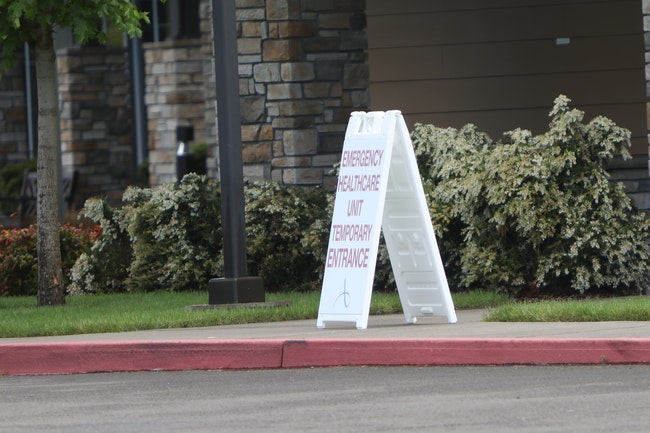
Salem Transitional Care (Amanda Loman/Salem Reporter)
Oregon’s reactive approach to regulating long-term care facilities likely contributed to Covid deaths in nursing homes and other congregate care settings, a report by state regulators has found.
State officials have highlighted that Oregon has fared relatively well during the pandemic, with fewer infections and deaths than most other states.
However, the report, released Wednesday by the Secretary of State’s Audits Division, found that the 31,581 residents living in Oregon’s long-term care facilities have been at particular risk. According to the report, 1,185 residents of long-term care and other congregate settings have died from the Covid, accounting for 54% of the state’s deaths from the virus.
“State regulations around infection control, staffing, and emergency preparedness for community-based care facilities are lacking,” reads the report. “Limited regulation may contribute to higher case and death rates, though other factors may also contribute.”
Care facilities have been the biggest source of Covid deaths in Marion County, according to the most recent numbers from county Health and Human Services. There have been 152 deaths in these facilities, more than half of all Marion County’s 290 deaths from the virus, according to a March 16 report.
In the early months of the pandemic, county health officials cited the high number of care facilities in Marion County as one reason for the county’s relatively high rate of Covid cases compared to other parts of the state.
There are currently four long-term care facilities in Marion County with active outbreaks, according to the Oregon Health Authority’s most recent weekly Covid report. In Polk County, there is one.
In March 2020, the Oregon Department of Human Services began placing orders on facilities with suspected or confirmed cases of Covid that brought additional restrictions and monitoring.
However, by the time the orders were in place the virus was already spreading, the report found. At the facilities with the 10 highest deaths, inspectors found infection control issues at seven of them even after orders had been put into place.
The report did give Gov. Kate Brown and state agencies credit for restricting visits, making the vaccine available in these facilities, developing a testing plan for residents and creating centers where people could recover after getting the virus. It also noted the challenges around already low-staffing levels and getting residents in memory care to wear masks and stay put.
Licensing inspections would help ensure that safety protocols are being followed at long-term care facilities, the report said. But the report said those inspections have stopped during the pandemic. Investigations into complaints have also slowed while staff have been directed elsewhere because of the pandemic, the report said.
The report also found that facilities fell short on infection control training and also described a fragmented response from the Oregon Health Authority and the Oregon Department of Human Services.
“The state has relied on educational efforts to ensure that facilities are complying with infection control protocols,” the report said. “But additional monitoring visits and financial penalties should now be considered an option for enforcement, particularly when problems are severe or persistent.”
The report called for publishing staff vaccination rates for facilities, incorporating the Long-term Care Ombudsman (which is independent of state agencies) into responses and better coordinating efforts between the Oregon Health Authority and the Oregon Department of Human Services.
The report includes a response from Patrick Allen and Fariborz Pakseresht, the respective directors of the Oregon Health Authority and Department of Human Services. They pointed out that Oregon has still done a better job of responding to Covid in long-term care facilities than other states.
They pointed to proactive steps each agency has taken, prioritizing counties where the virus had spread quickly, including Marion County.
They also said a total of $500,000 in penalties have been issued against facilities over the last year.
Contact reporter Jake Thomas at 503-575-1251 or [email protected] or @jakethomas2009.
SUBSCRIBE: A monthly digital subscription starts at $5 a month.
GIFT: Give someone you know a subscription.
ONE-TIME PAYMENT: Contribute, knowing your support goes towards more local journalism you can trust.









